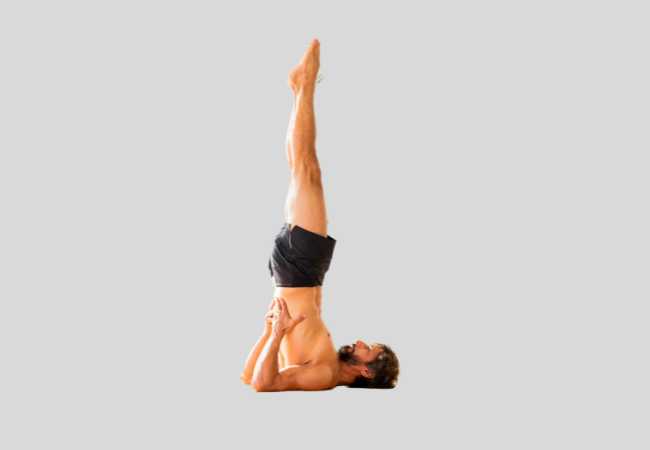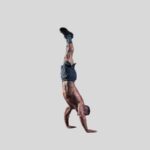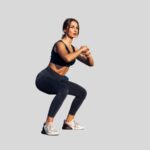The candlesticks exercise is an intermediate to advanced core move that challenges balance and torso strength. This gymnastics-inspired exercise is performed by lying on your back, lifting your straightened legs and arms vertically, and then lowering them with control. Executed properly, candlesticks torch the abs, obliques, hip flexors, and more.
Table of Contents
What is the Candlesticks Exercise?
Candlesticks involve lying flat on your back, flexing the hips to raise both legs and arms straight up toward the ceiling, then lowering them back with control. When performed correctly, the body forms a rigid column resembling an inverted candlestick.
The move requires balance, coordination, hamstring and hip flexor flexibility, and incredible core strength to stabilize the torso. It trains the abdominals isometrically, rather than through spinal flexion like crunches.
Muscles Worked During Candlesticks
Candlesticks primarily target the rectus abdominis, obliques, transversus abdominis, and hip flexors. The posterior chain including the spinal erectors, hamstrings, and glutes are worked isometrically to keep the body elevated and balanced. The shoulders and triceps are also activated when raising and lowering the arms.
Benefits of Candlesticks for Core Strength
Candlesticks train core stability and balance through an extended range of motion. Benefits include:
- Strengthening the entire core musculature isometrically
- Improving hip and hamstring flexibility
- Enhancing balance, body control and coordination
- Training spinal stabilization in a neutral position
- Developing strong obliques by resisting rotation
- Complementing flexion-focused ab moves like crunches
Related: Chest To Wall Vs Back To Wall Handstand
Proper Form and Technique for Candlesticks
Setup: Lie flat on your back with arms extended overhead and legs straight. Engage the core by drawing the navel towards the spine.
Engaging the Core: Initiate the movement by pressing low back towards the floor. Brace abdominals without holding your breath.
Lifting the Legs and Arms: In one controlled motion, simultaneously raise straightened legs and arms upwards. Reach as vertically as possible.
Lowering with Control: Maintaining a rigid torso, slowly lower legs and arms back to the start position. Do not relax your core.
Avoid arching the lower back at any point. Move through a full range of motion with control. Do not jerk or swing your legs and arms.
Modifications and Progressions
Scale the exercise to your current fitness level by:
- Easier: Bending knees, raising legs to only 45-90 degrees, partial range motion
- Harder: Extending legs straight, raising to full vertical position, slowing tempo
Adding Resistance to Candlesticks
To further challenge the core and hips, add resistance by:
- Placing small ankle/wrist weights
- Looping resistance bands above knees or arms
- Increasing lever length by extending arms overhead
- Candlestick Exercise Variations
- Several challenging variations include:
- Single Leg Candlesticks: Lift one leg at a time
- Oblique Candlesticks: Raise legs to one side alternating sides
- Overhead Candlesticks: Raise arms overhead instead of vertical
- Rotational Candlesticks: Rotate legs left to right during the raise
Effective ways to program candlesticks exercises:
- Warm Up: 2-3 sets with partial range of motion to activate the core
- Core Strength Training: 2-4 sets of 5-10 reps as a primary exercise
- Cooldown/Stretching: 1 set with bent knees focusing on control
Related: 9 Effective Tips For Yoga Handstand
Candlestick Workouts and Routines
Beginner Core Workout
- 2 sets 10 reps bent knee candlesticks
- 3 sets 8 reps reverse crunches
- 3 sets of 15-second plank holds
Intermediate Functional Training
- 3 sets 6 reps candlesticks
- 2 sets 8 reps single leg candlesticks on each side
- 5 sets 10 mountain climbers
Advanced Bodyweight Program
- 5 sets 8 reps slow eccentric candlesticks
- 3 sets 10 reps overhead candlesticks
- 4 sets of 12 rotational candlesticks
Common Injuries and How to Prevent Them
Candlesticks carry injury risks including:
- Lower back strain from overarching
- Neck hyperextension if the chin is raised
- Hamstring cramps if flexibility is lacking
Prevent injuries by:
- Maintaining a neutral spine position
- Avoiding jerky momentum
- Warming up thoroughly
- Only progressing gradually
Tips for Mastering Candlesticks
1. Engage the core fully before initiating the lift
2. Control motion very slowly and steadily
3. Keep neck and spine neutral, do not overarch
4. Breathe normally throughout the exercise
5. Use a full range of motion based on your flexibility
A Word From Blogzah
When performed correctly, candlestick exercises build incredible core strength from hips to shoulders. Remember to engage the core, maintain spine neutrality, control the range of motion, and breathe steadily. Work up progressively in difficulty by modifying leverage and range of motion. Candlesticks complement flexion abs moves for a complete core workout.
Are candlesticks good for abs?
Candlesticks, in the context of fitness, typically refer to a type of exercise or movement. They are not directly related to abdominal (abs) exercises, but they can indirectly contribute to core strength and stability.
A candlestick exercise is usually associated with gymnastics and involves rolling backward into a handstand-like position and then returning to a standing position without using your hands.
This exercise primarily works on your flexibility, balance, and overall body control.
If your goal is to strengthen your abdominal muscles, there are more targeted exercises you can incorporate into your routine. Some effective ab exercises include:
Crunches: These target the upper and mid-section of your abdominal muscles.
Leg Raises: Leg raises or hanging leg raises work your lower abs.
Planks: Planks help strengthen your entire core, including the abs.
Russian Twists: This exercise targets your obliques, which
are the muscles on the sides of your abdomen.
Bicycle Crunches: These engage both the upper and lower abs and incorporate some twisting motion for the obliques.
Sit-Ups: Traditional sit-ups engage your entire core, but be cautious with your form to avoid straining your neck.
Remember, building visible and strong abdominal muscles often goes hand in hand with a well-rounded fitness routine that includes cardio for fat loss and a healthy diet.
It’s important to consult with a fitness professional or personal trainer to create a workout plan tailored to your specific goals and needs.
How to do a candlestick lift?
A candlestick lift, in the context of fitness and gymnastics, is an exercise that involves rolling backward into a handstand-like position and then returning to a standing position.
This movement requires a good deal of flexibility, strength, and balance. Here’s a step-by-step guide on how to perform a candlestick lift:
Warning: This exercise can be advanced and challenging. Ensure you have the necessary strength and flexibility, and practice in a safe environment, preferably with a spotter if you’re a beginner.
Starting Position:
Begin in a standing position with your feet shoulder-width apart.
Keep your arms extended straight overhead, with your biceps close to your ears.
Roll Back:
Bend at your hips, allowing your torso to fold forward while keeping your legs and arms straight.
Slowly begin to roll backward, tucking your chin to your chest.
Full Roll:
Continue rolling backward until your legs and feet come over your head, and your body forms an inverted U-shape.
You’ll ideally end up in a position where your feet are above your head, and your body is in a straight line.
Pause at the Top:
When you reach the inverted position with your legs above your head, pause briefly to balance.
Keep your core engaged and maintain your balance.
Roll Forward:
From the inverted position, begin to unroll by tucking your knees toward your chest.
Roll forward, using your core and hip flexors to control the movement.
Return to Standing:
Continue rolling forward until your feet touch the ground.
Stand up straight with your arms overhead to complete the exercise.
Practice and Safety:
Candlestick lifts require practice and may take time to master. Start with small, controlled movements and gradually work up to a full candlestick.
Ensure you have a safe and soft surface to practice on, in case you lose balance or fall.
If you’re a beginner, it’s advisable to seek guidance from a fitness or gymnastics coach to ensure proper form and safety.
Candlestick lifts are an advanced exercise that requires flexibility and core strength. If you’re new to gymnastics or fitness, consider starting with easier exercises and progressively working your way up to more challenging movements like the candlestick lift.
Always prioritize safety and proper technique when attempting advanced exercises.
How many reps should I do?
Aim for 8-15 reps per set. Work up gradually while maintaining proper form.
What are some common mistakes?
Overarching low back, bending neck, jerky movement, improper breathing technique. Go slow and brace the core.
What muscles do candlesticks work?
Candlesticks target the rectus abdominis, obliques, transversus abdominis, hip flexors, hamstrings, glutes, shoulders, and triceps.
















